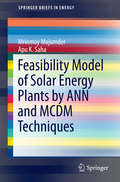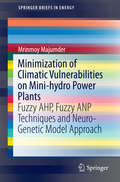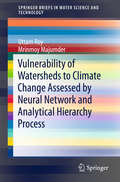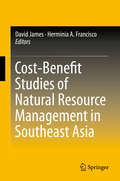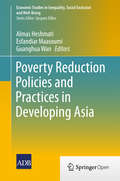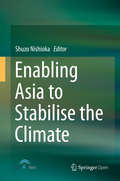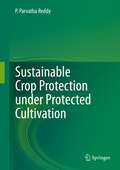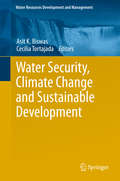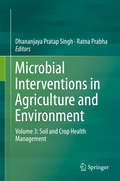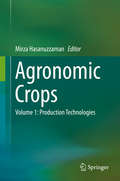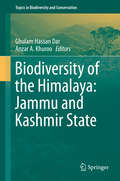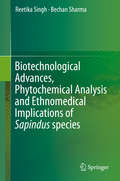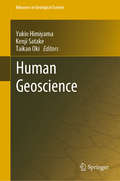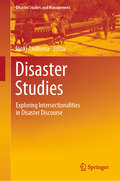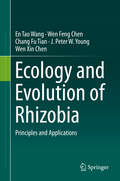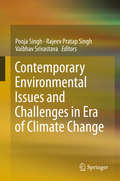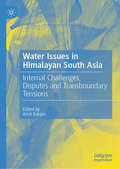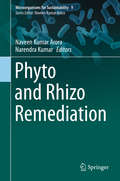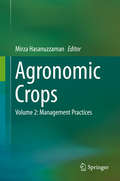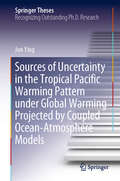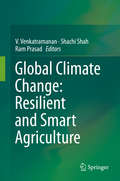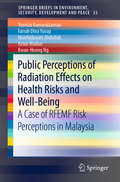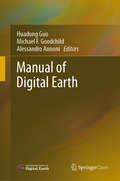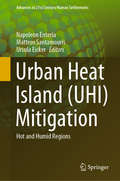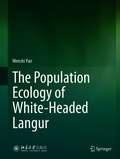- Table View
- List View
Feasibility Model of Solar Energy Plants by ANN and MCDM Techniques (SpringerBriefs in Energy)
by Mrinmoy Majumder Apu K. SahaThis Brief highlights a novel model to find out the feasibility of any location to produce solar energy. The model utilizes the latest multi-criteria decision making techniques and artificial neural networks to predict the suitability of a location to maximize allocation of available energy for producing optimal amount of electricity which will satisfy the demand from the market. According to the results of the case studies further applications are encouraged.
Minimization of Climatic Vulnerabilities on Mini-hydro Power Plants: Fuzzy AHP, Fuzzy ANP Techniques and Neuro-Genetic Model Approach (SpringerBriefs in Energy)
by Mrinmoy MajumderThis Brief presents the multi criteria decision making (MCDM) techniques like Fuzzy Analytical Hierarchy Process (AHP) and Fuzzy Analytical Network Process (ANP) to find out the importance of the influencing factors to develop the Climatic Vulnerability Index (CVI) that will represent the vulnerability of the Hydro-Power Plant (HPP) to climatic abnormalities. The cognitive ability of neuro-genetic modeling is applied to minimize CVI so that the conditions required to reduce the effect of climate change on HPP can be identified. The results from the study are found to be encouraging. The scarcity and pollution potential of conventional sources of energy has enforced scientists worldwide to look for efficient, flexible, cost effective but reliable alternative energy resources. Among many available options the energy extracted from water was found to be the least expensive, most flexible and moderately reliable renewable energy source which has the potential to replace the dependency on conventional fuels.
Vulnerability of Watersheds to Climate Change Assessed by Neural Network and Analytical Hierarchy Process (SpringerBriefs in Water Science and Technology)
by Uttam Roy Mrinmoy MajumderThe increase in GHG gases in the atmosphere due to expansions in industrial and vehicular concentration is attributed to warming of the climate world wide. The resultant change in climatic pattern can induce abnormalities in the hydrological cycle. As a result, the regular functionality of river watersheds will also be affected. This Brief highlights a new methodology to rank the watersheds in terms of its vulnerability to change in climate. This Brief introduces a Vulnerability Index which will be directly proportional to the climatic impacts of the watersheds. Analytical Hierarchy Process and Artificial Neural Networks are used in a cascading manner to develop the model for prediction of the vulnerability index.
Cost-Benefit Studies of Natural Resource Management in Southeast Asia
by David James Herminia A. FranciscoThis book applies cost-benefit analysis techniques in the management of environment and natural resources in developing countries of the Southeast Asian region and presents a compendium of studies conducted by researchers supported by the Economy and Environment Program for Southeast Asia (EEPSEA). It emphasizes the close relationship between the environment and natural resources and economic development in such countries, addressing a wide range of problems that can be understood using economic evaluation techniques. General guidelines for conducting economic appraisals are provided, with the case studies illustrating how they can be applied in a developing country context. Cost-Benefit Analysis Application in Environmental and Natural Resource Management in Southeast Asia serves as essential reading for teachers, researchers, students and practitioners in environmental and natural resource economics, economic development and key issues facing policymakers in the Southeast Asian region.
Poverty Reduction Policies and Practices in Developing Asia (Economic Studies in Inequality, Social Exclusion and Well-Being)
by Almas Heshmati Esfandiar Maasoumi Guanghua WanThis book looks at the major policy challenges facing developing Asia and how the region sustains rapid economic growth to reduce multidimensional poverty through socially inclusive and environmentally sustainable measures. Asia is facing many challenges arising from population growth, rapid urbanization, provision of services, climate change and the need to redress declining growth after the global financial crisis. This book examines poverty and related issues and aims to advance the development of new tools and measurement of multidimensional poverty and poverty reduction policy analysis. The book covers a wide range of issues, including determinants and causes of poverty and its changes; consequences and impacts of poverty on human capital formation, growth and consumption; assessment of poverty strategies and policies; the role of government, NGOs and other institutions in poverty reduction; rural-urban migration and poverty; vulnerability to poverty; breakdown of poverty into chronic and transitory components; and a comparative study on poverty issues in Asia and other regions. The book will appeal to all those interested in economic development, resources, policies and economic welfare and growth.
Enabling Asia to Stabilise the Climate
by Shuzo NishiokaThis book presents good practices in Asia and ASEAN countries for effectively promoting advances in response to climate change, which can help to achieve sustainable development in Asia and around the world. As a proposal, the aim is to influence the discussions at COP 21 by providing a positive agenda with concrete actions from an Asian perspective. The book is divided into three parts. Part 1 describes the greenhouse gas (GHG) reduction scenario from an Asian perspective and in line with global 2 ° targets. Based on modeling analysis, the studies demonstrate the theoretical potentials and send the policymakers at COP 21 the positive message that “Asia can reach the target.” As Asian countries vary in terms of their economic strength, country-specific scenario studies for the two giants China and India as well as for Japan and Vietnam are introduced to show the different approaches for each country. Part 2 shows successful examples of how modeling analysis are reflected in actual policy development, which provides practical guidelines to help policymakers develop their own roadmaps with stakeholder dialogue, not only in Asia but also in other regions of the world. The Nationally Appropriate Mitigation Action (NAMA) roadmap development in Thailand as well as the Iskandar Malaysia project show at the country and city level how researchers and policymakers are working closely to succeed. Part 3 focuses on a number of sector-specific activities including transportation, forestry, capacity development, and inventory work in Asia. Rather than discussing the Low Carbon Society (LCS) concept in detail, the respective chapters highlight unique, concrete, and practically applicable examples from Asia, showing how Asian countries are addressing climate change mitigation issues in a collaborative manner, an approach that can be replicated in other regions. While the ultimate goal of this book is to facilitate international climate regime making, local government and international organizations (United Nations, World Bank, and others) officers, researchers, international NGO/NPOs, consultants, students (particularly those studying international relationships or environmental studies), as well as reporters will find this book useful in broadening their understanding of low-carbon development in Asia.
Sustainable Crop Protection under Protected Cultivation
by P. Parvatha ReddyThis book focuses on pests (insect and mite) and diseases (fungal, bacterial, viral and nematode) in protected horticulture (fruits, vegetables and ornamentals) using physical, cultural, chemical, biological, host resistance, and integrated methods. It opens with chapters describing the setting in which integrated pest and disease control operates, i.e., the greenhouse and its environment. Subsequent chapters present the basic strategies and tactics of different control methods including integrated control, with special reference to greenhouse crops. Further chapters include the different facets of biological pest and disease control – its scientific bases, its development in practice, its commercialization and quality control. The concluding chapters of the book highlight the present status of integrated pest and disease control for the most important greenhouse crops (fruits, vegetables and flower crops) worldwide. The book’s final chapter explores future challenges for researchers assigned to identify non-pesticide methods and integrate sustainable pest management technologies that can contribute to increased productivity, such as breeding for durable resistance, biological control and devising integrated methods that will have minimal adverse environmental and social impacts.Among productivity-enhancing technologies, protected cultivation has a tremendous potential to increase the yield of vegetables and flower crops by several fold. Pests and diseases are one of the major challenges to protected cultivation. Year-round warm temperatures and relatively high humidity together with abundant food make the protected environment of greenhouses highly attractive to pests and diseases. Nevertheless, very little attention has been paid to the manipulation of greenhouse environments expressly to avoid disease epidemics and insect infestations, which together can easily account for 30% of crop losses.This book will be of immense value to all members of the scientific community involved in teaching, research and extension activities on protected horticulture. It also offers a useful reference guide for policymakers and practicing farmers, and can be used as a textbook for postgraduate courses.
Water Security, Climate Change and Sustainable Development (Water Resources Development and Management)
by Asit K. Biswas Cecilia TortajadaThis book pursues a comprehensive approach so as to arrive at a better understanding of the implications of climate change on sustainable development, focusing on the perspective of water. Climate change is one of today’s most pressing global issues and will become increasingly important in the decades to come, as societies will feel its pervasive impacts in many aspects of their lives. Given that the majority of these climate change impacts will be felt through the medium of water, the book explores the interrelationships and inter-linkages between water, climate change and sustainable development.
Microbial Interventions in Agriculture and Environment: Volume 3: Soil and Crop Health Management
by Dhananjaya Pratap Singh Ratna PrabhaMicrobial communities and their multi-functionalities play a crucial role in the management of soil and plant health, and thus help in managing agro-ecology, the environment and agriculture. Microorganisms are key players in N-fixation, nutrient acquisition, carbon sequestration, plant growth promotion, pathogen suppression, induced systemic resistance and tolerance against stresses, and these parameters are used as indicators of improved crop productivity and sustainable soil health. Beneficial belowground microbial interactions in the rhizosphere help plants combat abiotic challenges in the unfavourable environmental conditions of native soils. These microorganisms and their products offer potential solutions for agriculture in problematic areas since they are able to degrade xenobiotic compounds, pesticides and toxic chemicals and help remediate heavy metals in the rhizosphere and so make deteriorated soils suitable for crop production. This book compiles the latest research on the role of microbes in the rhizosphere and agro-ecology, covering interaction mechanisms, microbe-mediated crop production, plant and soil health management, food and nutrition, nutrient recycling, land reclamation, clean water systems, agro-waste management, biodegradation, bioremediation, biomass and bioenergy, sanitation and rural livelihood security. It is a comprehensive reference resource for agricultural activists, policymakers, environmentalists and advisors working for governments, non-governmental organizations and industries, helping them update their knowledge of this important, but often neglected, research area.
Agronomic Crops: Volume 1: Production Technologies
by Mirza HasanuzzamanAgronomic crops have been used to provide foods, beverages, fodders, fuels, medicines and industrial raw materials since the dawn of human civilization. Today, agronomic crops are being cultivated by employing scientific methods instead of traditional methods. However, in the current era of climate change, agronomic crops are subjected to various environmental stresses, which results in substantial yield loss. To meet the food demands of the ever-increasing global population, new technologies and management practices are being adopted to boost yield and maintain productivity under both normal and adverse conditions. Scientists are now exploring a variety of approaches to the sustainable production of agronomic crops, including varietal development, soil management, nutrient and water management, pest management, etc. Researchers have also made remarkable progress in developing stress tolerance in crops through different approaches. However, achieving optimal production to meet the increasing food demand is an open challenge. Although there have been numerous publications on the above-mentioned problems, and despite the extensive research being conducted on them, there is hardly any comprehensive book available. In response, this book offers a timely resource, addressing all aspects of production technologies, management practices and stress tolerance in agronomic crops in a single volume.
Biodiversity of the Himalaya: Jammu and Kashmir State (Topics in Biodiversity and Conservation #18)
by Ghulam Hassan Dar Anzar A. KhurooThe Himalaya, a global biodiversity hotspot, sustains about one-fifth of the humankind. Nestled within the north-western mountain ranges of the Himalaya, the Jammu and Kashmir (J&K) State harbours more than half of the biodiversity found in the Indian Himalaya. The wide expanse of State, spread across the subtropical Jammu, through the temperate Kashmir valley, to the cold arid Ladakh, is typical representative of the extensive elevational and topographical diversity encountered in the entire Himalaya.This book, the most comprehensive and updated synthesis ever made available on biodiversity of the J&K State, is a valuable addition to the biodiversity literature with global and regional relevance. The book, arranged into 7 parts, comprises of 42 chapters contributed by 87 researchers, each of whom is an expert in his/her own field of research. The precious baseline data contained in the book would form the foundation for assessing current status of knowledge about the bioresources, identify the knowledge gaps, and help prioritization of conservation strategies to steer the sustainable use of biodiversity in this Himalayan region. Given the breadth of topics covered under the banner of biodiversity in this book, it can surely serve as a model for documentation of biodiversity in other regions of the world. The book will be of immense value to all those who, directly or indirectly, have to deal with biodiversity, including students, teachers, researchers, naturalists, environmentalists, resource managers, planners, government agencies, NGOs and the general public at large.
Biotechnological Advances, Phytochemical Analysis and Ethnomedical Implications of Sapindus species
by Reetika Singh Bechan SharmaPlants have always occupied a prominent position in the life of every living being. Plants are the primary source of food, shelter and medicines. The global inclination toward herbal medicine has advanced the expansion of plant-based pharmaceutical industries to a vast extent. The production of traditional medicine at global market has been estimated to touch US $5 trillion by 2050. Some of the useful plant-based drugs include vinblastine, vincristine, taxol, podophyllotoxin, camptothecin, digoxigenin, morphine, codeine, aspirin, atropine, capscicine, allicin, curcumin, artemesinin and ephedrine. Genus Sapindus is an important economical and medicinal trees, distributed over the world. Soap nuts contain higher amount of saponin, a natural detergent which can be used to clean clothes and hairs. Sapindus species possesses various pharmacological properties including antimicrobial, antioxidant, anti-inflammatory, anticancer, hepatoprotective, anti-trichomonas activity. Extracts of this plant are rich in various phytochemicals and polyphenolic compounds. All the pharmacological properties are due to presence of saponins. Biotechnological techniques can improve the saponin content; thus this chemical content can be produced at large scale and can be used as phytomedicine. We hope that this book would be of great use to under graduates, postgraduates, scientists, researchers and faculty members who are studying, teaching or working in the field of Biotechnology, Phytochemistry and Ethnopharmacology. The techniques explained in this book could be of immense use for the researchers working in this area. We shall deeply appreciate receiving any critical comments and suggestions from the readers from the different parts of globe which would help us improve the first edition of this publication.
Human Geoscience (Advances in Geological Science)
by Yukio Himiyama Kenji Satake Taikan OkiThis book is a product of the joint efforts of interdisciplinary academic fields under the integrative framework of human geoscience. Human geoscience is a new genre of geoscience concerned with the natural phenomena that occur on the surface of the Earth and their relations with human activities. It therefore has connections with many fields of geoscience, namely, physical geography, geomorphology, geology, soil science, sedimentology, seismology, volcanology, meteorology, climatology, oceanography, and hydrology. It also has strong links to the humanities, social sciences, agricultural sciences, and engineering related to disaster prevention or mitigation. All these disciplines are important fields for understanding disasters and global environmental problems and for evaluating the associated risks comprehensively, then proposing mitigation strategies.The volume is designed for those who may not necessarily have a geoscience background but have broad scientific interest in understanding the causes, mechanisms, and consequences of geo-disasters and global environmental problems and wish to make the world more sustainable on that basis. The book consists of six parts: I. Introduction, II. Earth Surface Realms, III. Natural Resources and Society, IV. Natural Hazards and Society, V. Global Environmental Problems, and VI. Global Sustainability Programmes and Human Geoscience, which discusses the contribution of this field of science to a new comprehensive framework for global sustainability.
Disaster Studies: Exploring Intersectionalities in Disaster Discourse (Disaster Studies and Management)
by Janki AndhariaThis book covers several dimensions of disaster studies as an emerging discipline. It is the inaugural book in the series ‘Disaster Studies and Management’ and deals with questions such as “Is disaster management a field of practice, a profession, or simply a new area of study?” Exploring intersectionalities, the book also examines areas of research that could help enhance the discourse on disaster management from policy and practice perspectives, revisiting conventional event-centric approaches, which are the basis for most writings on the subject. Several case studies and comparative analyses reflect a critical reading of research and practice concerning disasters and their management. The book offers valuable insights into various subjects including the challenge of establishing inter- and multi-disciplinary teams within the academia involved in disaster studies, and sociological and anthropological readings of post-disaster memoryscapes. Each of the contributors has an enduring interest in disaster studies, thus enriching the book immensely. This book will be of interest to all the students and scholars of disaster studies and disaster management, as well as to practitioners and policymakers.
Ecology and Evolution of Rhizobia: Principles and Applications
by J. Peter Young En Tao Wang Wen Feng Chen Chang Fu Tian Wen Xin ChenThis book reviews the history and development of rhizobial ecology (diversity, function and interactions with the biotic and abiotic environments), evolution (genome diversification, systematics of symbiotic genes) and application. Further, it describes the new concept of rhizobia, the latest systematic methods, biogeographic study methods, and genomic studies to identify the interactions between rhizobia, legumes and environments. To enable readers to gain a comprehensive understanding of rhizobial biogeography, the book provides effective protocols for the selection and application of high-efficiency rhizobial inoculants. In addition, it presents standard and modern methods used in studies on rhizobial ecology and evolution in dedicated appendices, making it a unique and valuable handbook for researchers.
Contemporary Environmental Issues and Challenges in Era of Climate Change
by Pooja Singh Rajeev Pratap Singh Vaibhav SrivastavaOver the last few decades, unprecedented global population growth has led to increased demand for food and shelter. At the same time, extraction of natural resources beyond the Earth’s resilience capacity has had a devastating effect on ecosystems and environmental health. Furthermore, climate change is having a significant impact in a number of areas, including the global hydrological cycle, ecosystem functioning, coastal vulnerability, forest ecology, food security, and agricultural sustainability. According to the Intergovernmental Panel on Climate Change (IPCC), only immediate and sustained action will prevent climate change causing irreversible and potentially catastrophic damage to our environment. This book presents various scientific views and concepts, research, reviews, and case studies on contemporary environmental issues in changing climate scenarios and highlights different adaptation measures. Increasing awareness of modern-day patterns of climate change, it addresses questions often raised by environmental scientists, researchers, policymakers and general readers.
Water Issues in Himalayan South Asia: Internal Challenges, Disputes and Transboundary Tensions
by Amit RanjanThe book looks into the domestic water issues and disputes in the Himalayan South Asian countries, and based on it analyzes trans-boundary water disputes. Himalayan South Asia comprises India, Pakistan, Bangladesh, Nepal, Bhutan, and Afghanistan. All except Afghanistan share river waters with India. Home to some of the major river basins of the world, a part of this region falls into water scarce zone, and according to the United Nations Water Report of 2018 some of them will experience severe water scarcity by 2050.The book also studies water issues in China. Though the country is not a part of the Himalayan South Asia, most of the major rivers of this region originate in China. Over the years, China has been alleged by countries like India for diverting, choking or using the trans-boundary river waters for its purpose. Understanding water competition and issues in China will help one to understand its transboundary water behavior.
Phyto and Rhizo Remediation (Microorganisms for Sustainability #9)
by Naveen Kumar Arora Narendra KumarThe increasing human population and the associated activities have negatively influenced the ecosystems and life on earth. The continuous addition of agrochemicals, heavy metals and industrial wastes/ effluents in the ecosystems have caused great harm, including loss of productivity, biodiversity, climate change and diseases in plants, animals and humans, resulting in increased marginal lands and endangered sustainability of life on earth. Hence, there is an urgent need to reverse the impact of dangerous pollutants through a holistic, sustainable and biotic approach. Bioremediation involves the utilization of biological systems, mainly plants (phytoremediation) or microorganisms or both in combination (rhizoremediation) for the removal or degradation of pollutants and revive the habitats in an eco-friendly manner. Recently, there have been many success stories related to bioremediation involving plants or plant-microbe interactions. These success stories are related to the removal of heavy metals, pesticides, polyaromatic hydrocarbons, explosives, radionuclides or reduction of biological oxygen demand, total dissolved solids, total suspended solids, oil spills in water bodies. Rhizoremediation has also been successfully used for reclamation of saline or marginal soils. With the range of pollutants and the total area (on earth) covered by these toxic chemicals, it is important that these eco-friendly technologies be utilized in a better way. The book throws light on the recent happenings, research and success stories related to bioremediation of polluted habitats through phytoremediation or rhizoremediation. The book also highlights some of the significantly important plant and microbial species involved in remediation, the physiology, biochemistry and the mechanisms of remediation by various plants and microbes, and suggestions for future improvement of bioremediation technology.
Agronomic Crops: Volume 2: Management Practices
by Mirza HasanuzzamanAgronomic crops have provided food, beverages, fodder, fuel, medicine and industrial raw materials since the beginning of human civilization. More recently, agronomic crops have been cultivated using scientific rather than traditional methods. However, in the current era of climate change, agronomic crops are suffering from different environmental stresses that result in substantial yield loss. To meet the food demands of the ever-increasing global population, new technologies and management practices are being adopted to boost yields and maintain productivity under both normal and adverse conditions. Further, in the context of sustainable agronomic crop production, scientists are adopting new approaches, such as varietal development, soil management, nutrient and water management, and pest management. Researchers have also made remarkable advances in developing stress tolerance in crops. However, the search for appropriate solutions for optimal production to meet the increasing food demand is still ongoing. Although there are several publications on the recent advances in these areas, there are few comprehensive resources available covering all of the recent topics. This timely book examines all aspects of production technologies, management practices and stress tolerance of agronomic crops.
Sources of Uncertainty in the Tropical Pacific Warming Pattern under Global Warming Projected by Coupled Ocean-Atmosphere Models (Springer Theses)
by Jun YingThis book discusses the sources of uncertainty in future model projections of the tropical Pacific SST warming pattern under global warming. It mainly focuses on cloud radiation feedback and ocean dynamical effect, which reveal to be the two greatest sources of uncertainty in the tropical Pacific SST warming pattern. Moreover, the book presents a correction for model projections of the tropical Pacific SST warming pattern based on the concept of “observational constraints”; the corrected projection exhibits a more El Niño-like warming pattern.
Global Climate Change: Resilient and Smart Agriculture
by V. Venkatramanan Shachi Shah Ram PrasadThis book provides essential insights into methods and practices of ‘Climate-smart Agriculture,’ which is driven by the principles of climate resilience and smart resource use in agricultural production. Climate-smart agriculture is a key policy instrument for achieving poverty eradication and a hunger-free world, as well as mitigating the effects of climate change. This book discusses in detail climate-smart agricultural technologies and practices that can reduce the vulnerability of agricultural systems, improve the livelihoods of farmers and other stakeholders, and reduce the greenhouse gas emissions from crop production and livestock husbandry. The agriculture, forestry and other land use (AFOLU) sector produces roughly 10–12 gigatons of CO2-equivalent per year; therefore, sustainable practices for agriculture and related land use hold immense potential to mitigate climate change. The potential impacts of climate variability and climate change on agriculture are extensively documented and articulated, especially with regard to global and national environmental agendas that call for innovation, transformation and climate-resilient advances in agriculture. As the book demonstrates, climate-smart agriculture offers an excellent tool for boosting agricultural output to feed the growing global population; for reducing greenhouse gases emissions from agriculture and other land use; and for protecting agricultural production systems from the impending dangers of climate change.
Public Perceptions of Radiation Effects on Health Risks and Well-Being: A Case of RFEMF Risk Perceptions in Malaysia (SpringerBriefs in Environment, Security, Development and Peace #33)
by Yusniza Kamarulzaman Farrah Dina Yusop Noorhidawati Abdullah Azian Madun Kwan-Hoong NgThis book reports on the investigation of the public’s perception of Radio Frequency Electromagnetic Field (RF-EMF) radiation effects on health and well-being, in Malaysia. It elaborates on how understanding the impact of perceived risk is essential in order to investigate the explanatory value and effectiveness of interventions influencing these beliefs. The book expands on the knowledge and understanding of different risk perception related to radiation in order to explain the gap in literature regarding the relationship between risk perceptions that lead to public behaviors. In doing so, the book presents empirical findings of a national study that unveils two key factors affecting public risk perceptions: psycho-graphic and personal factors. It offers a more collective and cultural understanding of public perceptions on radiation risks via a systematic mixed-method research approach. Research in the book also show that while the radiation risk is recognizable and unavoidable, the relevant stakeholders should be more proactive and committed to communicate and rectify the perception of radiation. The book thus serves as a valuable source of reference to understand the debate and to invite more participatory dialogues on radiation risk perceptions among public.
Manual of Digital Earth
by Michael F. Goodchild Huadong Guo Alessandro AnnoniThis open access book offers a summary of the development of Digital Earth over the past twenty years. By reviewing the initial vision of Digital Earth, the evolution of that vision, the relevant key technologies, and the role of Digital Earth in helping people respond to global challenges, this publication reveals how and why Digital Earth is becoming vital for acquiring, processing, analysing and mining the rapidly growing volume of global data sets about the Earth. The main aspects of Digital Earth covered here include: Digital Earth platforms, remote sensing and navigation satellites, processing and visualizing geospatial information, geospatial information infrastructures, big data and cloud computing, transformation and zooming, artificial intelligence, Internet of Things, and social media. Moreover, the book covers in detail the multi-layered/multi-faceted roles of Digital Earth in response to sustainable development goals, climate changes, and mitigating disasters, the applications of Digital Earth (such as digital city and digital heritage), the citizen science in support of Digital Earth, the economic value of Digital Earth, and so on. This book also reviews the regional and national development of Digital Earth around the world, and discusses the role and effect of education and ethics. Lastly, it concludes with a summary of the challenges and forecasts the future trends of Digital Earth. By sharing case studies and a broad range of general and scientific insights into the science and technology of Digital Earth, this book offers an essential introduction for an ever-growing international audience.
Urban Heat Island: Hot and Humid Regions (Advances in 21st Century Human Settlements)
by Napoleon Enteria Matteos Santamouris Ursula EickerThis book discusses the concepts and technologies associated with the mitigation of urban heat islands (UHIs) that are applicable in hot and humid regions. It presents several city case studies on how UHIs can be reduced in various areas to provide readers, researchers, and policymakers with insights into the concepts and technologies that should be considered when planning and constructing urban centres and buildings. The rapid development of urban areas in hot and humid regions has led to an increase in urban temperatures, a decrease in ventilation in buildings, and a transformation of the once green outdoor environment into areas full of solar-energy-absorbing concrete and asphalt. This situation has increased the discomfort of people living in these areas regardless of whether they occupy concrete structures. This is because indoor and outdoor air quality have both suffered from urbanisation. The development of urban areas has also increased energy consumption so that the occupants of buildings can enjoy indoor thermal comfort and air quality that they need via air conditioning systems. This book offers solutions to the recent increase in the number of heat islands in hot and humid regions.
The Population Ecology of White-Headed Langur
by Wenshi PanThis book offers a rare and detailed insight into 20 years’ of in-depth field research and conservation of the white-headed langur. It focuses on the white-headed langur’s natural refuge, territory and home range, diets and foraging strategies, behavior modes, reproductive strategies, population, possible future viabilities, and their interaction with human society. From 1996 through 2016, a small research team led by Prof.Wenshi Pan from Peking University conducted studies and conservation efforts on the white-headed langur, one of the most endangered endemic species of China, in Guangxi and saved the species from extinction. With the help of conservationists’ efforts, the white-headed langur population in Nongguan Mountains, Guangxi, gradually increased from 105 to approximately 820.This book shares the success story of the unification of human development and wildlife conservation.
